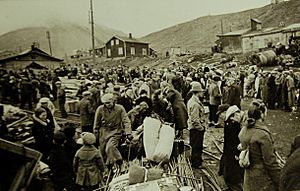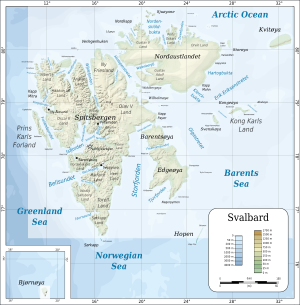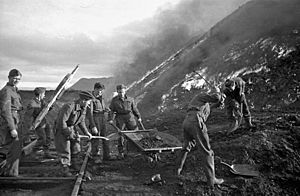Operation Gauntlet facts for kids
Quick facts for kids Operation Gauntlet |
|
|---|---|
| Part of the Arctic Campaign of the Second World War | |

Demolition of a German wireless station
|
|
| Type | Raid |
| Location | Spitzbergen, Svalbard, Norway 78°45′N 16°00′E / 78.750°N 16.000°E |
| Planned | Combined Operations |
| Commanded by |
|
| Objective |
|
| Date | 25 August – 3 September 1941 |
| Outcome | Success |
| Casualties | None |
Operation Gauntlet was a secret mission during the Second World War. It took place from August 25 to September 3, 1941. Soldiers from Canada, Britain, and Norway worked together. They landed on the Norwegian island of Spitzbergen. This island is part of the Svalbard Archipelago. It is about 650 miles (1,046 km) south of the North Pole.
The main goal was to stop Germany from using the islands' resources. There were coal mines on Spitzbergen. These mines were run by Norway and the Soviet Union. Both countries agreed to destroy the mines. They also wanted to evacuate their people. The mission aimed to prevent Germany from getting coal. It also stopped them from using the mining equipment. Another goal was to shut down wireless stations. These stations sent weather reports. Germany could use these reports for their military plans.
Operation Gauntlet was a big success. The Germans did not know about the mission. They could not stop the Allied forces. No Allied soldiers were hurt. The local people were safely taken away. Several German ships were captured. A German warship was even sunk on the way back.
Contents
Why Was Svalbard Important?
The Svalbard Archipelago is in the Arctic Ocean. It is about halfway between northern Norway and the North Pole. The islands have tall, snowy mountains. Some parts are covered in glaciers. In winter, the islands are covered in snow. The bays freeze over.
The main island is Spitzbergen. It has large inlets called fiords on its west coast. Isfjorden is one of these. It is up to 10 miles (16 km) wide. The Gulf Stream makes the sea warm enough. This means the sea is ice-free in summer.
People lived in settlements like Longyearbyen and Barentsburg. These were along the south shore of Isfjorden. Other settlements were in Kongsfjorden and Van Mijenfjorden. People from many countries lived there. The Svalbard Treaty of 1920 made the islands neutral. It also said that different countries could mine and fish there.
Before 1939, about 3,000 people lived on Svalbard. Most were Norwegians and Russians. They worked in the coal mines. Coal was moved from the mines to the shore. By 1939, about 500,000 long tons (508,000 tonnes) of coal were produced each year. Norway and the Soviet Union each produced about half of this.
In 1940, a German warship, the Admiral Hipper, sailed near Svalbard. It was looking for British ships. The British government wanted to stop Germany from getting coal. They also wanted to shut down the wireless stations. These stations sent weather reports. These reports helped German military operations.
After Germany invaded the Soviet Union in June 1941, the Arctic became more important. German control of Svalbard could threaten supply routes. These routes were used to send goods to North Russia. The British Navy was ordered to send ships to the Arctic. This was to work with the Soviet Union.
British commanders visited northern Russia. They found that Murmansk was too close to German areas. Its air defenses were not strong enough. Rear-Admiral Philip Vian then explored Spitzbergen. He wanted to see if it could be a naval base. His ships, HMS Nigeria and HMS Aurora, sailed there. But Vian found that Spitzbergen was too close to German bases in Norway. German planes spotted his ships twice.
Planning the Mission
Allied Preparations for Gauntlet
In July 1941, the Canadian Corps in Britain offered troops. They wanted to help with a landing on Spitzbergen. This force was called Force 111. It included Canadian infantry, engineers, and medical teams. The plan was to set up a naval base. But the mission's goals were later changed.
By August 1941, the mission was smaller. The new goal was to destroy or remove mining equipment. They also planned to burn coal and damage transport systems. Wireless and weather stations would be disabled. Russian civilians would go to Archangelsk. Norwegian civilians would go to Britain.
Russian and Norwegian officials joined the expedition. A Norwegian army officer, who would be the new Governor of Spitzbergen, also came. Force 111 included 29 Canadian officers and 498 other ranks. It also had 14 British officers and 79 men. A small group of Norwegian soldiers also joined. In total, 645 men were part of the force.
Operation Gauntlet in Action

The expedition left Scotland on August 19. They sailed on the ship Empress of Canada. They met up with warships like Nigeria and Aurora. The ships stopped in Iceland to refuel. On August 22, the soldiers learned their destination.
On August 24, the force neared Spitzbergen. A plane flew over Isfjorden to check the area. Early on August 25, a small boat landed a signal team. They went to the Kap Linne wireless station. Norwegian operators welcomed them. The main ships entered Isfjorden. They anchored near Barentsburg, a Soviet mining town.
The Canadian commander met with Soviet officials. They discussed evacuating the people. Canadian soldiers also took control of other settlements. The evacuation took longer than planned. The Soviet Consul wanted to load machinery and supplies onto the ship.
The Empress of Canada sailed for Archangelsk on August 26. It was escorted by Nigeria and destroyers. Aurora stayed behind to protect the landing parties. Canadian engineers set fire to about 450,000 long tons (457,000 tonnes) of coal. Fuel oil was burned or poured into the sea. Mining equipment was removed or destroyed. Barentsburg mysteriously burned down during this time. The Empress of Canada returned on September 1.
The Norwegian Military Governor kept the wireless station running. But he sent fake fog reports. This was to stop German planes from flying over. Three coal ships were captured. A whaling ship, an icebreaker, a tug, and two fishing boats were also taken. On September 2, about 800 Norwegians boarded the Empress. Also, 186 French prisoners of war joined them. They had escaped from German camps.
The Allied force left for home on September 3. They had spent ten days on the island. The wireless stations were destroyed. A German station was heard trying to call Spitzbergen. The fake weather reports had worked. German weather planes had canceled their flights.
On September 5, a German plane flew over Svalbard. The crew saw Spitzbergen was empty. The coal piles were still burning. German weather flights started again. On September 10, a German crew saw a man waving at Longyearbyen. This was Anders Halvorssen. He had hidden and stayed on the island.
The Germans found a flat area near Longyearbyen. It was about 1,500 yards (1,370 m) long. It could be used as a runway. On September 25, a German plane landed there. But its radio was too weak. Another German plane landed on September 27. It found Halvorssen. The Germans planned to set up a temporary base. But they saw strange lights in the sky. They thought it might be the British. So, the planes quickly left for Norway.
On the way back, the British warships looked for German ships. On September 7, they found a German convoy. The British ships sank a German training ship. But two troop transports escaped. These ships had 1,500 German soldiers on board. The British ship Nigeria was damaged. It was thought to have hit a wreck. Later, it was believed to have hit a mine. The Allied force arrived back in Scotland on September 7.
What Happened Next?
After the mission, a German expert suggested setting up a weather station on Svalbard. This would help get better weather data. It would also help German weather planes. This plan was called Operation Bansö. It started on October 8. A German plane flew to Svalbard. It carried four men and ten workers. They planned to turn a house into a weather station.
On October 18, a German plane saw British ships near the island. The next day, another German plane spotted British ships. The German planes quickly left the airstrip. One plane had engine trouble. But dust clouds hid the aircraft. So, they were not seen. The all clear was given on October 22. By November 9, Bansö was working. Many flights had brought equipment and builders to the island.
Who Was Involved?
This section lists the main groups of soldiers and support staff involved in Operation Gauntlet.
|
Canadian Forces
Norwegian Forces
|
British Forces
|
Images for kids
See also
- Operation Fritham
- Operation Gearbox
- Operation Gearbox II
- Operation Zitronella
- Operation Haudegen





